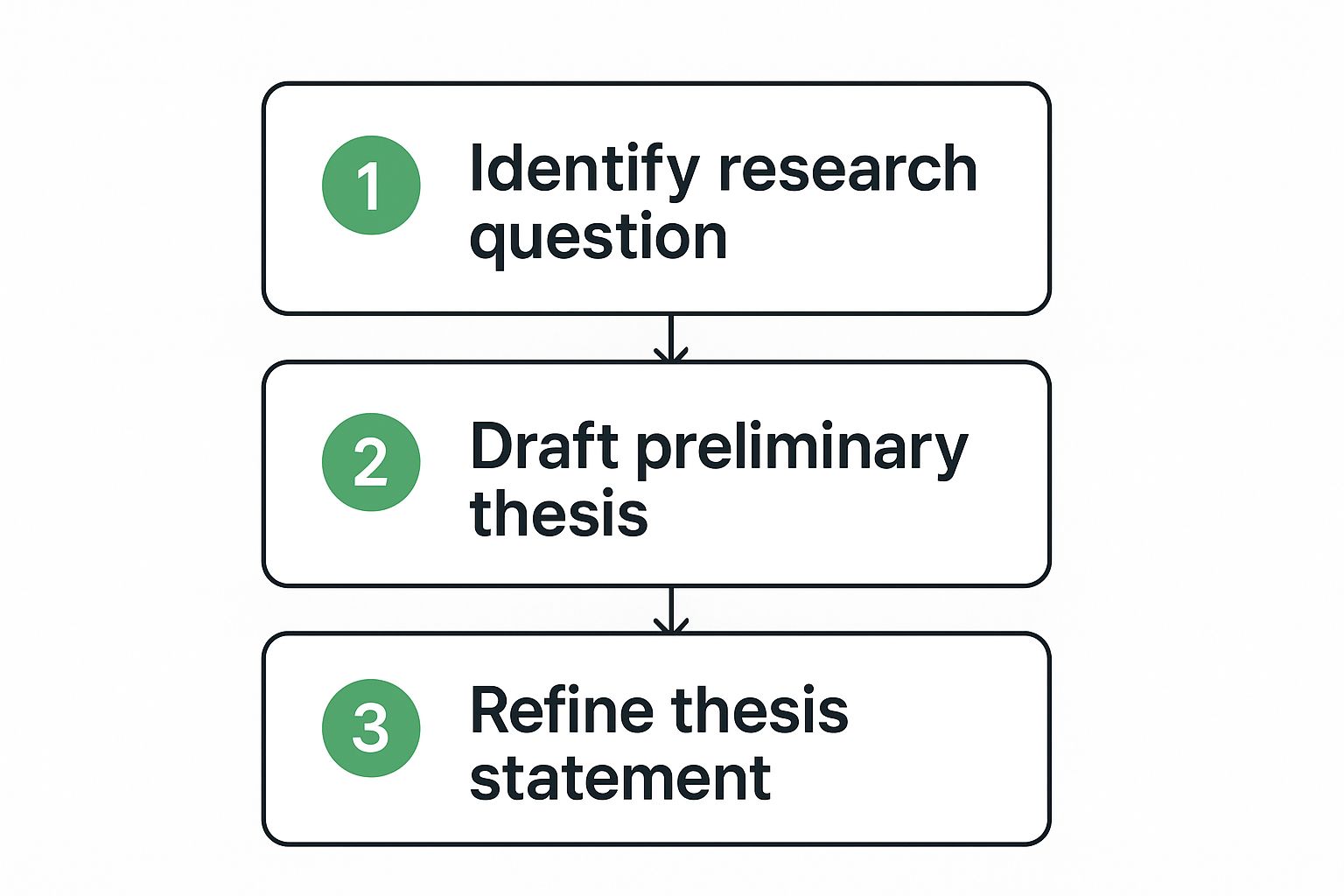
How to Write a Research Paper Outline: Guide & Tips
October 5, 2025
Staring at a blank page is intimidating for just about everyone. But the secret to writing a great research paper isn't some flash of genius—it's having a plan before you even start.
Think of your research paper outline as a strategic advantage. It’s the blueprint for your argument, making sure every point has a purpose and connects to the next in a way that just makes sense. A solid outline is your best defense against those frustrating, time-wasting rewrites down the line.
Why Your Outline Is the Secret to a Better Paper
I like to think of a research paper outline as the architectural plan for a building. You wouldn't just start throwing up walls without a detailed plan, right? The same goes for writing a complex academic paper. It's hands-down the single best tool for transforming your writing process from chaotic to controlled.
A great outline forces you to really nail down your thesis, organize your evidence, and spot the weak points in your logic before you've sunk hours into writing paragraphs that lead nowhere. This isn't just about listing topics in order. It's about building a strong, coherent argument from the ground up. When you master the outline, you’re not just organizing ideas—you're setting yourself up for a persuasive, successful paper.
The Proven Impact of Outlining
The value of outlining isn't just a hunch; it's a practice that's been proven over decades of academic work. The formal use of outlines really took hold in universities back in the early 20th century.
By the 1950s, educational researchers had figured out just how critical it was. Studies from that era showed that students who used detailed outlines before drafting had 30-40% better thesis clarity and logical flow.
Fast forward to today, and the practice is almost universal, with over 85% of university students globally using them. Writing centers all over the world will tell you that a good outline can boost your drafting efficiency by up to 50%. You can dig deeper into the history and impact of outlining in this global trends report.
A research paper outline doesn't just structure your thoughts; it reveals them. It's the first moment you can truly see if your argument holds together or if it's built on a shaky foundation.
Key Benefits of Outlining Before You Write
Here’s how creating a detailed research paper outline directly impacts the quality and efficiency of your writing process.
| Benefit | Impact on Your Research Paper |
|---|---|
| Logical Flow | Ensures your arguments are presented in a coherent sequence, making your paper more persuasive and easier for readers to follow. |
| Clarity of Argument | Forces you to refine your thesis statement and supporting points, eliminating ambiguity and strengthening your overall message. |
| Increased Efficiency | Drastically reduces writing time by preventing writer's block and minimizing the need for extensive revisions and restructuring later. |
| Identifies Gaps | Helps you see where your research is thin or where evidence is lacking, allowing you to address these weaknesses before you write. |
Ultimately, taking the time to outline saves you a massive amount of stress and rework. It turns a jumble of ideas into a clear, compelling argument that’s much easier to write.
Laying the Groundwork Before You Start
A powerful research paper outline doesn't just appear out of thin air. It’s built on a solid foundation of preliminary work that happens long before you type "I. Introduction."
Think of it as gathering your materials before you start building. This prep work makes the actual outlining process smooth and logical instead of a frustrating guessing game.
The most critical first step is transforming a broad topic into a sharp, arguable thesis statement. This statement is the north star for your entire paper. It’s not just a topic; it's an argument you intend to prove.
From Broad Idea to Focused Thesis
Let’s say a student is interested in the effects of remote work. That's a huge topic. To make it manageable, they need to get specific.
- Initial Idea: The impact of remote work. (Way too broad.)
- Narrowed Focus: How remote work affects urban planning. (Better, but it's still just a topic, not an argument.)
- Working Thesis: The widespread adoption of remote work is forcing small and mid-sized cities to fundamentally redesign their urban centers away from commercial-centric models and towards mixed-use residential zones to survive economically.
Now that is a thesis. It's specific, arguable, and gives you a clear direction. It tells you exactly what the paper needs to prove and even hints at a preliminary structure: introduce the trend, show the economic pressure on cities, explain the shift in urban design, and then focus on the move to mixed-use zones. Every single point in your outline must now serve this central argument.
Once you have a working thesis, it's time for some preliminary research. You aren’t writing the paper yet—you're just confirming you have enough evidence to actually support your claim. This is a crucial reality check. You'll be gathering potential sources, quotes, and data points that feel promising.
As you gather this information, mastering effective summarization techniques will be a huge help. You need to distill complex sources into concise points. These summaries become the building blocks for your outline, ensuring each section has real substance behind it.
Your preliminary research isn’t about finding all the answers. It’s about confirming that the questions posed by your thesis have answers you can find and use as evidence.
This early research phase will likely involve a lot of literature reviews and identifying the key studies in your field. While you're still in the planning stage, it’s smart to think ahead about how you'll present your research process. For a detailed guide on this, you can explore our article on how to write a method section for a research paper. This groundwork ensures your outline is a strategic map for a convincing argument, not just a list of ideas.
Building Your Outline From the Ground Up
Okay, let's get practical. Building a research paper outline isn’t about getting every detail right from the start. It’s a layering process, where you move from the big, foundational ideas down to the specific evidence that will hold up your arguments.
Imagine you're tackling a paper on AI's role in creative writing. Your first move isn't to jot down every thought. Instead, you start with the skeleton—the universally recognized sections of any academic paper.
These are your non-negotiables:
- Introduction: This is where you'll land your thesis statement.
- Literature Review: Where you show you've done your homework and place your work in the bigger conversation.
- Main Body: The heart of your paper, where you build your case.
- Conclusion: Where you wrap it all up and point to what's next.
Think of these as the main pillars of your structure. For a deeper look at that second pillar, our guide on how to write a literature review is a great resource.
Choosing Your Outline Style
With your pillars in place, you need to decide how much detail to sketch in. You've basically got two options here: the topic outline and the sentence outline.
A topic outline is your quick-and-dirty map. It uses keywords and short phrases to get the flow of your ideas down on paper. It's perfect for brainstorming because it's flexible—you can move pieces around easily as your thinking evolves.
On the other hand, a sentence outline forces you to be more deliberate. Each point is a full sentence, which essentially makes you write a mini-summary for every paragraph. It's more work upfront, but it can make the actual writing process feel like you're just connecting the dots.
This infographic captures that initial process perfectly—it's all about sharpening your main idea before you even start building the structure.

As you can see, a clear research question and a solid thesis are the bedrock. You can't build a sturdy outline without them.
From Major Sections to Granular Sub-Points
Now, let's put some meat on those bones. Using a classic alphanumeric format, we can start adding layers. The whole point is to create a logical flow where every sub-point is there for a reason, directly supporting the larger idea above it.
Here’s a quick look at what our topic outline for the AI paper might start to look like:
I. Introduction
A. Hook: The explosion of AI writing tools (like ChatGPT, Sudowrite)
B. Thesis Statement: While AI can augment the creative process, its reliance on existing data patterns limits its ability to produce truly original narrative innovations.
II. Literature Review
A. Early history of automated writing
B. Current studies on AI and creativity
C. The gaps in what's already been studied
Here’s something I’ve learned over the years: an outline is a living document, not a stone tablet. You should expect to tweak and refine it as you dig deeper into your research. The best outlines are flexible guides, not rigid cages.
And this isn't just a hunch. A recent survey of 10,000 university students found that 78% rely on an outline for papers over 3,000 words. Their outlines typically had 3 to 5 levels of hierarchy with 15 to 25 total points. What’s really telling is that 62% of them went back and revised their outlines two or three times. Planning is a dynamic process.
The real magic of a multi-level outline is how it forces you to think about connections. You can instantly see where an argument is flimsy or where you need more evidence. It lets you fix major structural problems before you've wasted hours writing paragraphs that were doomed from the start.
Choosing the Right Tools and Format
The way you decide to build your research paper outline can make all the difference. Seriously. The format you pick and the tools you use can either make the whole process feel intuitive or add a layer of friction you just don't need. It’s all about finding a workflow that clicks with your brain and the demands of your specific project.

Ultimately, you want your outline to be a living, breathing document—something you can easily shuffle around as your research gets deeper and your ideas start to sharpen.
Selecting Your Outline Structure
The two big players in formal outlining are the alphanumeric and decimal systems. Each has its own vibe and is better suited for certain kinds of academic work.
The Alphanumeric System (I, A, 1, a): This is the classic format you probably learned back in high school. It’s perfect for humanities and social science papers, where you’re building a narrative or a layered argument. The clear hierarchy makes it easy to see how your smaller points are propping up the bigger themes.
The Decimal System (1.0, 1.1, 1.1.1): This one is a favorite in the sciences and engineering for a reason. Its numerical precision is a lifesaver for technical papers where you might need to cross-reference sections. If your paper is packed with complex methods or data sets, the decimal format brings a ton of clarity.
Think of it this way: for a literary analysis of a novel, the alphanumeric system helps you weave together arguments about theme and character. But for a lab report detailing a meticulous experiment, the decimal system gives you a far more logical and easy-to-follow structure.
The best format is the one that makes your argument's logic instantly visible to you. Don't get too caught up in the rules; pick the system that helps you think most clearly.
Finding the Right Outlining Tools
Just as important as the structure is your choice of tools. This is where personal preference really takes the wheel, with options ranging from old-school analog to slick digital apps.
The classic pen-and-paper or index card method is fantastic for visual and kinesthetic thinkers. There's something powerful about spreading cards out on a table and physically rearranging your argument. It’s a tactile process that can spark new connections and help you see your ideas from a different angle—all without digital distractions.
On the other end of the spectrum, you have digital tools. Dedicated outlining software like MindMeister or even a simple document in Microsoft OneNote can be incredibly powerful. They make editing a breeze, allow for easy collaboration, and let you link directly to your research sources. The shift here is undeniable. In fact, the user base for these kinds of tools saw an increase of 150% between 2017 and 2024, which shows just how much students and pros are embracing digital organization. You can dig into this trend in this detailed global report.
Your decision really comes down to your workflow. If you think best by physically moving ideas around, stick with index cards. If you need a clean, easily editable document that integrates with your digital research, an app is the way to go.
To help you decide, here’s a quick breakdown of some common outlining tools and methods.
Comparison of Outlining Tools and Methods
| Tool/Method | Best For | Key Advantage | Potential Drawback |
|---|---|---|---|
| Pen and Paper | Visual, kinesthetic learners who want a distraction-free space. | Tactile and flexible; allows for non-linear brainstorming. | Difficult to edit or reorganize on a large scale. |
| Index Cards | Projects with many moving parts that need to be reordered. | Highly modular; makes it easy to visualize and restructure flow. | Can become cumbersome and easy to misplace. |
| Word Processors | Straightforward, linear outlines that don't need much visual flair. | Familiar and widely accessible (e.g., Word, Google Docs). | Can feel rigid; not ideal for complex idea mapping. |
| Mind Mapping Software | Brainstorming and exploring connections between ideas visually. | Great for non-linear thinking and seeing the big picture. | Can become cluttered; may need to be converted to a linear format. |
| Dedicated Outlining Apps | Detailed, hierarchical projects requiring deep organization. | Powerful features like hoisting, focus mode, and collapsing sections. | Might have a learning curve or subscription cost. |
Ultimately, there's no single "best" tool. The goal is to find the method that feels the least like a chore and the most like an extension of your own thinking process. Try a couple of different approaches and see what sticks.
Turning Your Outline Into a First Draft
With a solid research paper outline in hand, the heavy lifting is already done. That intimidating blank page? It’s gone, replaced by a clear roadmap for your writing. Now, the goal is to translate that structured blueprint into a flowing first draft without losing your momentum.

Think of your outline as a series of prompts. Your main job is to expand each point—from the Roman numerals down to the lowercase letters—into complete paragraphs.
To keep from feeling overwhelmed, focus on one section at a time. You don't even have to start with the introduction. In fact, it’s often easier to begin with the section you feel most confident about.
Your Outline Is a Guide, Not a Cage
One of the biggest mistakes I see writers make is treating their outline like a rigid set of rules. This can completely stifle the new ideas and connections that naturally pop up during the writing process.
Your outline is a guide, not a cage. Think of it as a GPS—it’s okay to take a detour when you discover a more scenic or logical route along the way.
If a compelling new idea surfaces while you're writing, don’t just ignore it because it wasn't in the original plan. Pause for a moment. Think about how it fits into your overall argument, and if it makes sense, adjust your outline. The best papers always evolve.
The structural coherence your outline provides is invaluable. Editors from top-tier journals estimate that about 80% of the manuscripts they accept show the clear organization that comes from a well-crafted outline. This is a stark contrast to the rejection rate of over 50% for submissions with poor structure, which often signals a flawed or ignored plan.
Practical Strategies for Drafting
As you start to flesh out each section, keep your writing clear and direct. Applying essential writing tips can make a huge difference in the quality of your first draft, ensuring it's both professional and easy to follow.
Here are a few actionable strategies to make the process smoother:
- Write in Bursts: Try using a timer for focused 25-minute writing sprints. The goal here is just to get words on the page, not to make them perfect.
- Use Placeholders: If you can't find the perfect word or need to look up a statistic, just drop in a placeholder like “[TK-STAT]” or “[REPHRASE]” and keep moving. Don’t let small roadblocks kill your flow.
- Connect Your Paragraphs: Make sure each paragraph flows logically into the next. Use transitional phrases to guide your reader smoothly through your argument.
Your first draft is about getting the ideas down, not getting them perfect. Don't edit while you write—that’s a completely separate stage. The only goal right now is to transform your structural points into prose.
Remember, a strong outline makes every part of the paper easier to write, including the summary sections. For more guidance on that, check out our detailed article on how to write an abstract.
Got Questions About Research Paper Outlines? We’ve Got Answers.
Even with a solid plan, a few questions always pop up when you're piecing together a research paper outline. It's totally normal. Let's tackle some of the most common ones so you can move forward with confidence.
So, how detailed does an outline really need to be? The honest answer is, it depends on your project and your style. For a shorter paper, a simple topic outline with just keywords and phrases might be all you need to stay on track.
But if you’re staring down a complex dissertation, a detailed sentence outline is your best friend. Crafting each point as a full sentence forces you to think through your logic early on, which can save you a ton of headaches later.
Another big one: is it okay to change my outline after I start writing? Absolutely. In fact, you should. Your outline isn't a set of rigid rules carved in stone; it's a living guide. As you dive deeper into your research and writing, you'll uncover new connections and ideas. Your outline should evolve right along with your understanding of the topic.
Is All This Outlining Really Worth the Time?
This is a fair question, especially when you feel the pressure of a deadline. The short answer is a resounding yes. The time you invest up front pays for itself by helping you sidestep writer's block and avoid massive structural edits down the road.
The data backs this up, too. A 2019 meta-analysis of over 5,000 students found that those who built a comprehensive outline before writing scored, on average, 25% higher grades.
On top of that, a separate study showed that doctoral candidates who used a formal outline finished their degrees 18% faster. If you're curious, you can review the full analysis to dig into these academic performance findings.
An outline doesn't just save you time; it improves the quality of your work. It's the single best way to ensure your final paper is coherent, logical, and persuasive.
So, how much time should this take? There’s no magic number, but a good rule of thumb is to spend about 10-15% of your total project time on planning and outlining. For a project that’ll take you a month, that’s about three or four days dedicated to building a solid foundation. Trust me, that upfront investment makes the rest of the process so much smoother.
Ready to turn your well-structured outline into a polished, human-sounding paper? Natural Write is a free platform designed to transform AI-generated text into natural, engaging language that bypasses AI detectors. Refine your drafts, improve clarity, and ensure your writing sounds like you.
Try Natural Write for free and humanize your text in one click


